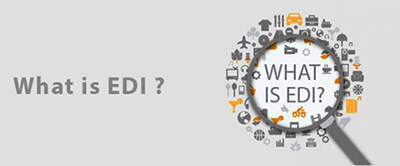What is EDI? As a furniture retailer, it’s your job to stay informed, stay proactive and—most importantly—stay effective in today’s growing eCommerce world. Customers want the best products out there, and they want them now. If you’re like most small or medium-sized furniture brands who want to grow, you’re constantly staring down fast-paced, ever-relevant competitors like Wayfair and Amazon.
What makes these eCommerce titans so successful? Well, a number of things do. Like other heavy-hitting digital sellers, though, the furniture world’s biggest fish have one thing in common: They sell products quickly, and without the need for human intervention. They’ve adopted Electronic Data Interchange, or EDI, as a technological cornerstone of modern selling.
Electronic Data Interchange
 Are you asking yourself, “What is EDI?” EDI is the process of sharing information between you and your vendors that are using different systems. This information is passed along through today’s standard electronic formats. The idea, here, is to remove the need for human intervention (and errors). Think of it this way…
Are you asking yourself, “What is EDI?” EDI is the process of sharing information between you and your vendors that are using different systems. This information is passed along through today’s standard electronic formats. The idea, here, is to remove the need for human intervention (and errors). Think of it this way…
EDI is the translator and transportation for delivering your business documents to your trading partners.
Each of your trading partners may be using a different ERP system. EDI makes the different ERP systems talk to each other by exchanging important business documents through the whole fulfillment process.
EDI is here. And more importantly, it’s accessible. If you’ve researched EDI solutions in the past, you’ll be familiar with all of the impact to the supply chain. In traditional B2B transactions, it looks a lot like this:
- Step One: The purchaser creates an order.
- Step Two: The purchaser prints the transaction copy.
- Step Three: The purchaser emails, mails or faxes the printed purchase to the vendor.
- Step Four: Vendor inputs the Purchase Order in their own system
- Step Five: The vendor prepares the Purchase Order Acknowledgement
- Step Six: Vendor prints PO Acknowledgement
- Step Seven: The Vendor emails, mails or faxes the printed PO acknowledgment to the vendor.
- Step Eight: The purchaser inputs the PO Acknowledgement in their system to recognize any exceptions from the Purchase Order.
A similar process is repeated for Ship Notices, Invoices and other business documents.
It’s a lengthy process—which is why growing sellers are adopting Electronic Data Interchange. EDI removes the need for paper. As a result, your business doesn’t need the long process above. When two businesses use EDI, the B2B transaction happens like this:
- Step One: The purchaser creates the order, inputting procurement details.
- Step Two: The purchaser’s system sends this information to the vendor’s system.
- Step Three: A PO acknowledgment is created in vendor’s system and sent back to the purchaser system immediately.
- Step Four: PO acknowledgment is reconciled with the PO and an exception report is immediately created
And all of the above happens without any human intervention.
Connecting the Entire Home Furnishings Industry
Understandably, EDI makes a business process substantially efficient. What is EDI specifically for the home furnishings industry? Businesses are implementing this high-speed, no-hassle solution to become better connected with other businesses. In the shipping world, for example, EDI is adopted to process bill of lading and shipping notices. In the insurance world, EDI is used to trade client information. It’s also used to assist agents in creating commission reports. EDI connects the dots.
What does EDI do for the furniture industry? Between EDI’s astounding cost efficiency, speed and accuracy, it’s becoming a must-have tech solution. Furniture providers suffer from long shipping times, sometimes caused by confusion and delays in exchanging purchasing and shipping information. When it’s time to buy, sell and trade products, a speedier process is always better. Let’s take a closer look at the benefits EDI offers.
Accuracy
Because EDI eliminates human errors, accuracy increases. If you’ve adopted EDI, you won’t have to worry about receiving incorrect orders. You won’t have to deal with illegible faxes or documents, either. If you’ve connected with other furniture sellers, expect a quick, effective transaction. Your days of back-and-forth communication will be over!
Speed
Your business will be faster—and so will its partners. Instead of needing weeks to trade information, you can seal the deal in mere minutes. You’ll also eliminate these slow, and sometimes clumsy, processes:
- Document filing
- Document printing
- Document handling
Administrative Control
If you optimize your bottom line, your management team will have more time to innovate. EDI transactions are completed in real-time. Thus, they’re better at making informed decisions.
Modern EDI systems connect suppliers with customers, too. This network is a digital “reference point,” removing the need for info-digging when a problem arises. Topside, furnishing business administrators can change their needs immediately. There’s no need for business-to-business updates when the change happens all at once.
Value-Added EDI with the Power to Drive eCommerce
Because online selling dominates today’s retail world, it’s no surprise furniture companies are using EDI to succeed online. Businesses who want to save money, be more efficient and create quick buying options, eventually, find themselves diving into eCommerce.
As other furniture businesses become connected, they can access larger customer markets. They can also use their network to reach new suppliers. EDI might have been created to optimize selling, but its evolution has entered the Internet.
EDI lets distributors and retailers engage speedy, reliable communications. Because EDI connects retailers with distributors, it’s easy for a retailer to check for product availability with the vendor or the distributors on the fly.
This quick-reference capability is invaluable to businesses who dabble in eCommerce. EDI also lets a supplier’s website communicate with other suppliers in the industry. From the ground floor, EDI has given immeasurable opportunities to business online—regardless of their size.
Retailers: Ensure Supply Chain Compliance and Visibility
EDI gives retailers the freedom to focus on their staff. It also lets them increase supply chain sustainability by boosting compliance. Using EDI as a business communication tool, a furniture retailer can detect errors made during the ordering process. Then, they can eliminate them. Finally, they can focus on why these errors have happened.
Because EDI offers incredible insight into the supply chain, retailers can use EDI-provided information to iron out any inconsistencies. The use of EDI directly results in improved accuracy—all the while helping decision makers create new levels of compliance.
Because EDI is a proven, safe and reliable technology, many companies across the world use it. As a result, quite a lot of information exists to help furniture business’s meet certain standards. This factor increases, and promotes, the use of highly visible supply chain operations.
Manufacturers: Ensure Efficiency and Retail Compliance
Manufacturers using EDI can significantly reduce the order-to-shipment cycle time. Omnichannel EDI is expected to become the future’s solution to streamlining customer experiences across all platforms. By leveraging EDI with smartphone, desktop and tablet selling, a manufacturer can assure efficiency via the sheer power of eCommerce.
Meanwhile, manufacturing leaders can examine retailer viability as a quick, efficient provider. In the same way retailers can study the supply chain, manufacturers can examine their outlets. They can even measure the effectiveness of unique retail solutions offered by furniture providers, including:
- Same day furniture delivery
- In-store pickup
- Furniture set discounts
Logistics: Automating and Streamlining Operations
The production of consumer goods has slowly increased for nearly a decade. Now, the world is flooded with many options. As a furniture provider, you’ll need to be as efficient as possible to survive, thrive and expand.
You can implement EDI as a cross-company solution. When a manufacturer and its retailers can send, receive and share information in mere seconds, optimization opportunities are nearly endless. Long-term sustainability is possible, even for growing furniture businesses.
Remember: Optimization begins with automation. Until your business can automate information, it won’t be able to automate its structure, its selling options or its eCommerce platform. By adopting EDI, your brand will grow rapidly. It will also break free of the limitations which slow—or even stop—the industry’s other providers.
At the same time, EDI offers the best networking capabilities in existence. Become part of a bigger selling world, and make your mark as a trusted, efficient seller.
While you’ve learned “what is EDI”, how does it benefit your business? Follow us for more information.





